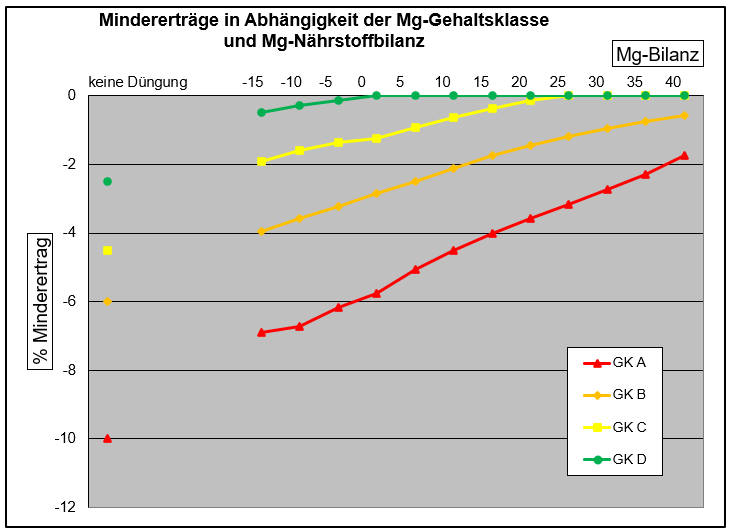Nährstoff Magnesium
Bedeutung des Nährstoffs
- wird für zahlreiche Stoffwechselprozesse benötigt
- zentraler Baustein des Chlorophylls (Blattgrün), deshalb ist Mg unentbehrlich für die Photosynthese
- der Mg-Gehalt des Bodens ist unmittelbar abhängig vom Ausgangssubstrat der Bodenbildung, z.B. sind tonige Böden von Grund auf besser mit Mg versorgt
- hoher Mg-Gehalt des Bodens (Überversorgung) kann für die Pflanzen trotzdem einen Nährstoffmangel bedeuten → verminderte Aufnahme von Ca und K durch die Pflanze
Empfehlungen für die Düngung
- Böden mit niedrigen pH-Werten können mit Mg-haltigen Kalken aufgedüngt werden, sodass neben dem pH-Wert auch die Mg-Versorgung verbessert wird
- bei einem hohen Mg-Bedarf sollten schnell pflanzenverfügbare, wasserlösliche Düngerformen eingesetzt werden (z.B. Magnesiumsulfat)
- feste Mg-Dünger müssen erst durch die Pflanze umgewandelt werden, ehe sie aufgenommen werden können und sind deshalb für eine langfristige Aufdüngung geeignet
Ertragseffekte zu Magnesium
Folgende Ertragseffekte sind allgemein bei Magnesiumdüngung auf initial suboptimal versorgten Standorten in Feldversuchen ermittelt worden (leichter-, mittlerer-, schwerer Boden):

Importance of the nutrient
- is required for numerous metabolic processes
- central building block of chlorophyll (leaf green), so Mg is indispensable for photosynthesis
- the Mg content of the soil is directly dependent on the starting substrate of the soil formation, e.g. clayey soils are better supplied with Mg from scratch
- high soil magnesium content (oversupply) can still mean a lack of nutrients for the plants → reduced absorption of Ca and K by the plant
Recommendations for fertilization
- Soils with low pH values can be fertilized with limes containing Mg, so that not only the pH value but also the Mg supply is improved
- If there is a high demand for Mg, plant-based, water-soluble fertilizer forms should be used quickly (e.g. magnesium sulfate)
- solid magnesium fertilizers must first be converted by the plant before they can be absorbed and are therefore suitable for long-term fertilization
